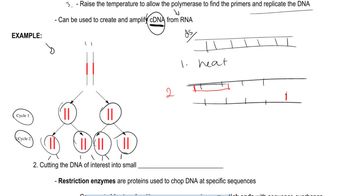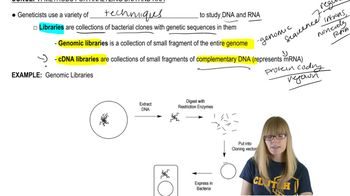Table of contents
- 1. Introduction to Genetics51m
- 2. Mendel's Laws of Inheritance3h 37m
- 3. Extensions to Mendelian Inheritance2h 41m
- 4. Genetic Mapping and Linkage2h 28m
- 5. Genetics of Bacteria and Viruses1h 21m
- 6. Chromosomal Variation1h 48m
- 7. DNA and Chromosome Structure56m
- 8. DNA Replication1h 10m
- 9. Mitosis and Meiosis1h 34m
- 10. Transcription1h 0m
- 11. Translation58m
- 12. Gene Regulation in Prokaryotes1h 19m
- 13. Gene Regulation in Eukaryotes44m
- 14. Genetic Control of Development44m
- 15. Genomes and Genomics1h 50m
- 16. Transposable Elements47m
- 17. Mutation, Repair, and Recombination1h 6m
- 18. Molecular Genetic Tools19m
- 19. Cancer Genetics29m
- 20. Quantitative Genetics1h 26m
- 21. Population Genetics50m
- 22. Evolutionary Genetics29m
18. Molecular Genetic Tools
Methods for Analyzing DNA
Problem 28a
Textbook Question
In a dideoxy DNA sequencing experiment, four separate reactions are carried out to provide the replicated material for DNA sequencing gels. Reaction products are usually run in gel lanes labeled A, T, C, and G.
How does PCR play a role in dideoxy DNA sequencing?
 Verified step by step guidance
Verified step by step guidance1
<span>Understand the role of PCR in dideoxy DNA sequencing: PCR (Polymerase Chain Reaction) is used to amplify the DNA segment of interest, providing enough material for sequencing.</span>
<span>Recognize that in dideoxy sequencing, also known as Sanger sequencing, PCR is modified to include chain-terminating dideoxynucleotides (ddNTPs) along with normal deoxynucleotides (dNTPs).</span>
<span>Note that each of the four separate reactions contains a different ddNTP (ddATP, ddTTP, ddCTP, or ddGTP), which terminates DNA synthesis at specific nucleotides.</span>
<span>Realize that the incorporation of ddNTPs during PCR results in DNA fragments of varying lengths, each ending at a specific nucleotide corresponding to the ddNTP used in that reaction.</span>
<span>Finally, these fragments are separated by size using gel electrophoresis, allowing the sequence of the original DNA to be determined by reading the order of terminated fragments in the gel lanes labeled A, T, C, and G.</span>
Recommended similar problem, with video answer:
 Verified Solution
Verified SolutionThis video solution was recommended by our tutors as helpful for the problem above
Video duration:
3mPlay a video:
Was this helpful?
Key Concepts
Here are the essential concepts you must grasp in order to answer the question correctly.
Polymerase Chain Reaction (PCR)
PCR is a technique used to amplify specific DNA sequences, making millions of copies of a target segment. This amplification is crucial for dideoxy DNA sequencing, as it ensures there is enough DNA material to analyze. By using cycles of denaturation, annealing, and extension, PCR enables researchers to generate sufficient quantities of DNA for sequencing reactions.
Recommended video:
Guided course

Genetic Cloning
Dideoxy Sequencing Method
The dideoxy sequencing method, also known as Sanger sequencing, involves incorporating dideoxynucleotides (ddNTPs) into DNA strands during replication. These ddNTPs terminate the elongation of the DNA strand, resulting in fragments of varying lengths that can be separated by gel electrophoresis. The specific ddNTPs used in the reactions correspond to the bases A, T, C, and G, allowing for the determination of the DNA sequence.
Recommended video:
Guided course

Sanger Sequencing
Gel Electrophoresis
Gel electrophoresis is a technique used to separate DNA fragments based on their size. In the context of dideoxy sequencing, the amplified DNA fragments produced from PCR are loaded into a gel matrix and subjected to an electric field. Smaller fragments migrate faster than larger ones, allowing for the visualization of the different lengths of DNA strands, which correspond to the sequence of nucleotides in the original DNA sample.
Recommended video:
Guided course

Proteomics

 7:40m
7:40mWatch next
Master Methods for Analyzing DNA and RNA with a bite sized video explanation from Kylia Goodner
Start learningRelated Videos
Related Practice


